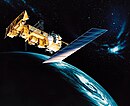TIROS-1
 The TIROS-1 prototype on display at the Smithsonian National Air and Space Museum. | |
| Mission type | Weather satellite |
|---|---|
| Operator | NASA[1] |
| Harvard designation | 1960 β 2 |
| COSPAR ID | 1960-002B |
| SATCAT no. | 29 |
| Mission duration | 75 days (90 days planned) |
| Spacecraft properties | |
| Spacecraft type | TIROS |
| Manufacturer | RCA Astro |
| Launch mass | 122.5 kilograms (270 lb) |
| Start of mission | |
| Launch date | 1 April 1960, 11:40:09 GMT |
| Rocket | Thor DM 18-Able II |
| Launch site | Cape Canaveral, LC-17A |
| End of mission | |
| Last contact | 15 June 1960 |
| Orbital parameters | |
| Reference system | Geocentric |
| Regime | LEO |
| Eccentricity | 0.00401 |
| Perigee altitude | 693 kilometres (431 mi) |
| Apogee altitude | 750 kilometres (470 mi) |
| Inclination | 48.40° |
| Period | 99.16 minutes[2] |
| Epoch | 1 Apr 1960 11:45:00 |
| Instruments | |
| two slow-scan visible television camera (wide-angle and narrow-angle) horizon sensor sun angle sensor | |
TIROS-1 (or TIROS-A) was the first successful low-Earth orbital weather satellite, and the first of a series of Television Infrared Observation Satellites.
Program
The TIROS Program was NASA's first experimental step to determine if satellites could be useful in the study of the Earth. At that time, the effectiveness of satellite observations was still unproven. Since satellites were a new technology, the TIROS Program also tested various design issues for spacecraft: instruments, data and operational parameters. The goal was to improve satellite applications for Earth-bound decisions, such as "should we evacuate the coast because of the hurricane?".[1]
The TIROS-1 Program's first priority was the development of a meteorological satellite information system. Weather forecasting was deemed the most promising application of space-based observations.[1]
Spacecraft
TIROS 1 was an 18-sided right prism, 107 centimetres (42 in) across opposite corners and 56 centimetres (22 in) high. Spacecraft power was supplied by approximately 9000 1 centimetre (0.39 in)- by 2 centimetres (0.79 in) silicon solar cells mounted on the cover assembly and by 21 nickel-cadmium batteries. A single monopole antenna for reception of ground commands extended out from the top of the cover assembly. A pair of crossed-dipole telemetry antennas (235 MHz) projected down and diagonally out from the baseplate. Mounted around the edge of the baseplate were five diametrically opposed pairs of small, solid-fuel thrusters that maintained the satellite spin rate between 8 and 12 rpm. The satellite was equipped with two 561.27 centimetres (220.97 in)-diameter vidicon TV cameras, one wide angle and one narrow angle, for taking earth cloudcover pictures. The pictures were transmitted directly to a ground receiving station or were stored in a tape recorder on board for later playback, depending on whether the satellite was within or beyond the communication range of the station. The satellite was spin-stabilized.[2]

Mission

Launched into orbit from Cape Canaveral Space Launch Complex 17A on 1 Apr 1960 at 11:40:09 UTC by a Thor Able II rocket,[4] the satellite performed normally from launch until June 15, 1960, when an electrical power failure prevented further useful TV transmission.[2]
Over its two-and-a-half month lifespan, TIROS 1 returned 23,000 photos of the Earth, 19,000 of them usable for weather analysis. For the first time, it was possible to view large scale cloud patterns in their totality, and from this, identify storm regions. The satellite provided the first long-term observations of a developing storm from orbit, tracking the disintegration of a large cyclonic mass off the coast of Bermuda over the course of four days. In addition, TIROS 1 returned data on smaller scale structures such as tornadoes and jet streams, and findings returned from the satellite complemented and enhanced ground-based findings.[5]: 35
TIROS 1 remains in orbit as of November 2020.[6]
See also
References
- ^ a b c "TIROS". NASA Science. Retrieved December 8, 2013.
- ^ a b c "TIROS 1". NASA Space Science Data Coordinated Archive. Retrieved November 14, 2020.
- ^ Anderson, George D. (April 1, 2010). "The first weather satellite picture". Weather. 65 (4): 87. Bibcode:2010Wthr...65...87A. doi:10.1002/wea.550. ISSN 1477-8696.
- ^ McDowell, Jonathan. "Launch Log". Jonathon's Space Report. Retrieved November 14, 2020.
- ^ Significant Achievements in Satellite Meteorology 1958-1964. Washington D.C.: NASA. 1966.
- ^ McDowell, Jonathan. "Satellite Catalog". Jonathon's Space Report. Retrieved November 14, 2020.
External links
- Track the current position of TIROS 1
- TIROS – NASA Science
- Final Report on the TIROS I Meteorological Satellite System
- The Smithsonian National Air & Space Museum Exhibition List
- TIROS 1 & 2 Ground Control Canter at Camp Evans - preserved by InfoAge Science History Center
- Published story of how the first TIROS photo was flown by helicopter, then a jet from the Camp Evans Ground Control Center to NASA
- TIROS I is Launched - NOAASIS
- TIROS-1 50th Anniversary & Resources on Satellite Meteorology
- NASA's YouTube video of TIROS-1

